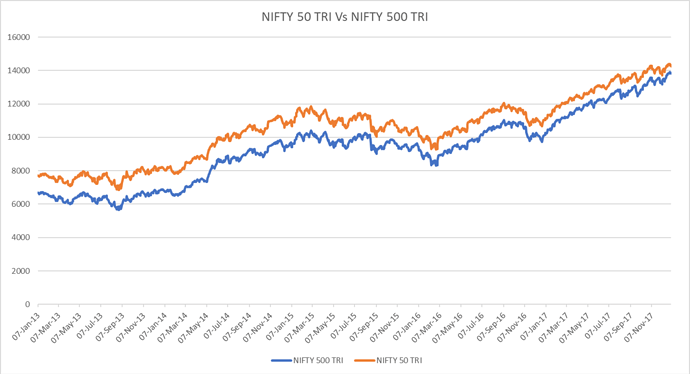Moreover, you may not restrict yourself to strictly the index companies. You may also include some really solid MidCaps or other large companies that you think are well established. Only condition is, buy them low.
You are a genius man. Great analysis and informative article. Keep going 
@jamit05 I’m all for Risk Management. If someone is worried about a correction, they should buy Protective Puts, not sit on the sidelines until a ‘crash’ happens. I understand that higher P/E levels are followed by below-normal returns, but nobody can predict what the P/E level will be, say, a month from now.
All I’m trying to say is, it really doesn’t make that much of a difference in passive investments. Because the whole idea of passive investments is that you buy all the time, regardless of P/Es, because very long term average returns always converge to the mean.
Finally, both the quotes you mentioned refer to ‘Market Timing’ specifically. I fail to understand how the quotes are about intraday trading.
And @Savishesh I have to disagree here. Active Investments and Passive Investments are completely different ballgames. Researching the broad market data gives no specific guidance towards Active Investments, maybe just a general, foggy sense of returns in the very long term.
Thank you @nikhilnik1234. Much appreciated.
Replying to your earlier post, @Savishesh
I downloaded NIFTY 500 TRI data for just the last 5 years (I know, I’m lazy). The correlation co-efficient between the data was 0.996 and can be represented as below:
I suspect that the results would be exactly the same regardless of whether I test the NIFTY, SENSEX or BSE 500. It makes no sense to repeat the research for these indices or any index in India.
There is no need to set the timeline of a month. Or three months. It could happen next year. Whenever PE levels normalize we may restart SIP.
We know that whatever money we put in now, will surely give mildly positive to negative returns in the next three years. Then might as well FD it and wait.
All of this above conversation is for Nifty ETFs and not individual stocks, because we have done a detailed study of Nifty PE.
Not only intraday trading, but any kind of short term trading. These quotes strongly advice you against “predicting” or “timing” market behaviour. Writers are authorities in value investing, and they profess only buying when the price is cheap.
Again, they specifically use the phrase ‘market timing’ - which is a specific phrase by all by itself indicating that one can predict when to enter or exit the market so as to maximize their gains. I fail to see how it is just about short term bets.
I tend to agree with your interpretation of Market timing… No one can exactly predict what and when will be the peak and low …
And Market timing does not mean you stand out when >23 and jump in < 18… It is gradually moving to cash position when the Market PE is very high and slowly add in when the PE level has reached to our comfort…
Staying fully in and trying to hedge at a point also Market timing … Likely to fail and all the gain in one instrument will go in the other…
Hope my understanding is right
I beg to slightly differ in the sense that: Accumulate cash when you’re no longer able to find a good company at a bargain price.
Even if you read Warren Buffet’s latest Annual Letter, this is the reason he gives for their built-up pile of $100+ Billion.
Now That Many High PE companies like Bajaj Finance or DIVIS lab or PI Industries have been included in the Index and Many Low PE PSU companies are out of Index, the past data of Nifty PE and corresponding Returns at That particular PE level may have changed for Higher PE…Hence Those who were thinking of exiting at above 23 PE and entering into at 17 PE, need to change their PE cut-off for entry and exit.
Also as Howard Marks says, Markets move in cycles…Your data analysis also shows that NIfty has moved in cycles of high PE and Low PE…So it makes sense to enter or deploy more money when PE is at Low and Either stay invested to come out at highe levels… This just one activity for passive investors in Index can definately increase the average returns by atleast 2 to 3 %. We dont have to be Passive for the sake of passivity. Tracking PE level of nifty is not a load of work. It can be done with just 2 minutes visit to NSE website. Itnaa to kar sakte hai yaar for wealth creation…

